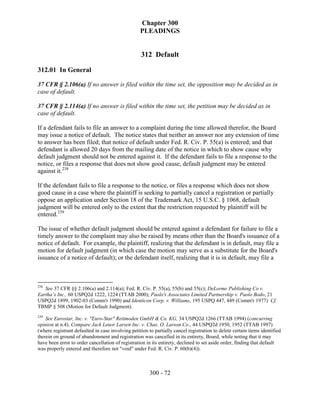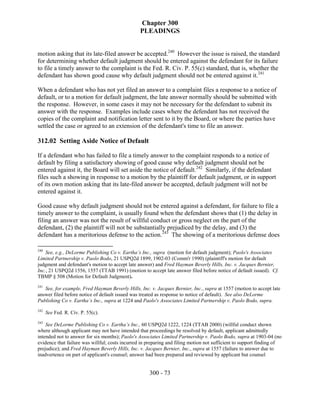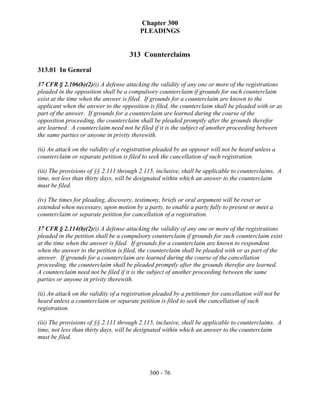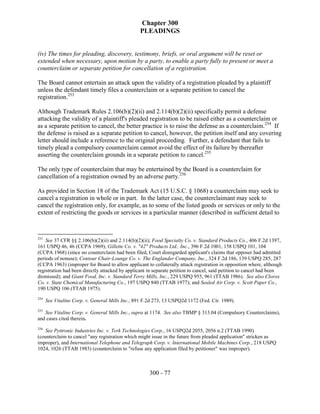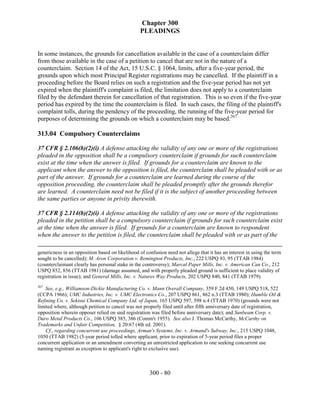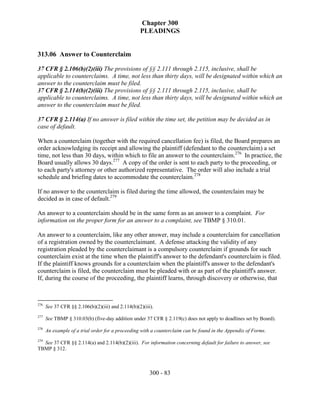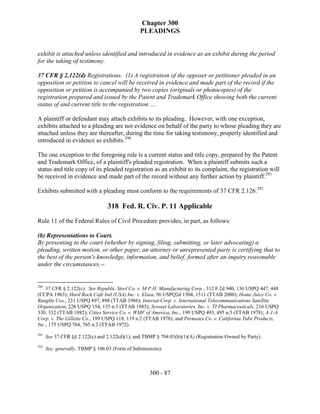This document discusses the types of inter partes proceedings before the Trademark Trial and Appeal Board, including oppositions, cancellations, interferences, and concurrent use proceedings. It provides details on who may file an opposition or petition to cancel a trademark registration and the required timing and procedures for doing so. Key points covered include the difference between opposing a mark's registration versus petitioning to cancel a registered mark, as well as the fees, forms, and other requirements for commencing these proceedings.
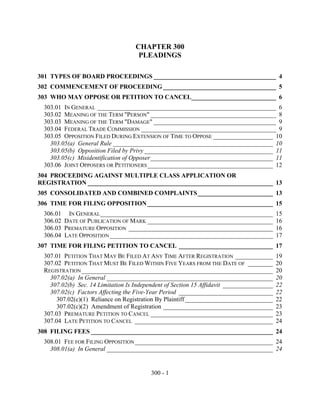
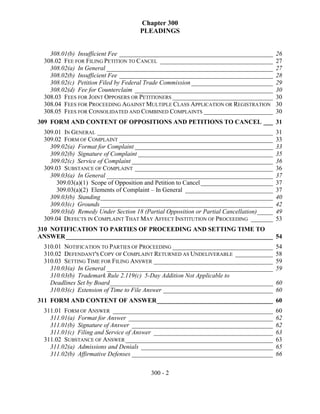

![Chapter 300
PLEADINGS
301 Types of Board Proceedings
The Board has jurisdiction over four types of inter partes proceedings, namely, oppositions,
cancellations, interferences, and concurrent use proceedings.1
An opposition is a proceeding in which the plaintiff seeks to prevent the issuance of a
registration of a mark on the Principal Register. "Any person who believes that he would be
damaged by the registration of a mark" may file an opposition thereto, but the opposition may be
filed only as a timely response to the publication of the mark, under Section 12(a) of the Act, 15
U.S.C. § 1062(a), in the Official Gazette of the USPTO.2
Mark on Supplemental Register Not Subject to Opposition:
15 U.S.C. § 1092 [Section 24 of the Trademark Act] Marks for the supplemental register
shall not be published for or be subject to opposition, but shall be published on
registration in the Official Gazette of the Patent and Trademark Office. Whenever any
person believes that he is or will be damaged by the registration of a mark on this
register, including as a result of dilution under section 43(c), he may at any time, upon
payment of the prescribed fee and the filing of a petition stating the ground therefor,
apply to the Director to cancel such registration. ...
Although the mark in an application for registration on the Principal Register is published
for, and subject to, opposition, the mark in an application for registration on the
Supplemental Register is not.3
Accordingly, the Board must reject any opposition filed with respect to the mark in an
application for registration on the Supplemental Register. The opposition papers will be
returned to the person who filed them, and any opposition fee submitted will be refunded.
The remedy of the would-be opposer lies in the filing of a petition to cancel the
registration of the mark, once the registration has issued.4
1
See also TBMP § 102.
2
See Section 13 of the Act of 1946, 15 U.S.C. § 1063. See also Section 68(a)(2) of the Act, 15 U.S.C. §
1141h(2)(a) (an application filed under Section 66(a) of the Trademark Act, 15 U.S.C. § 1141(f), is subject to
opposition under Section 13 of the Act).
3
See Sections 12(a), 13(a), and 24 of the Act, 15 U.S.C. §§ 1062(a), 1063(a), and 1092. See also TBMP § 205
(Mark on Supplemental Register).
4
See Section 24 of the Act, 15 U.S.C. § 1092.
300 - 4](https://image.slidesharecdn.com/300-130323073311-phpapp02/85/300-4-320.jpg)
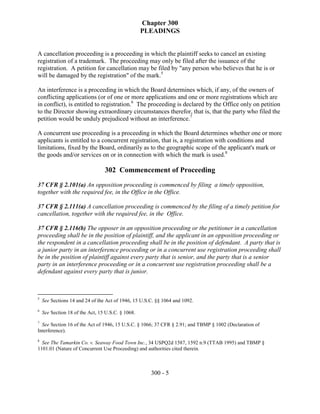
![Chapter 300
PLEADINGS
37 CFR § 2.116(c) The opposition or the petition for cancellation and the answer correspond to
the complaint and answer in a court proceeding.
An opposition proceeding is commenced by the timely filing of a notice of opposition, together
with the required fee, in the USPTO.9 Similarly, a cancellation proceeding is commenced by the
timely filing of a petition for cancellation, together with the required fee, in the USPTO.10
The notice of opposition, or the petition for cancellation, and the answer thereto correspond to
the complaint and answer in a court proceeding.11 The opposer in an opposition proceeding, or
the petitioner in a cancellation proceeding, is in the position of plaintiff, and the applicant in an
opposition proceeding, or the respondent in a cancellation proceeding, is in the position of
defendant.12
An interference proceeding commences when the Board mails a notice of interference to each of
the parties to the proceeding, as described in 37 CFR § 2.93.13
A concurrent use proceeding commences when the Board mails a notice of the proceeding to
each of the parties thereto, as described in 37 CFR §§ 2.99(c) and 2.99(d)(1).
For further information concerning interference and concurrent use proceedings, see TBMP
chapters 1000 and 1100, respectively.
303 Who May Oppose or Petition to Cancel
303.01 In General
15 U.S.C. § 1063(a) [Section 13(a) of the Trademark Act] Any person who believes that he
would be damaged by the registration of a mark upon the principal register, including as a result
of dilution under section 43(c), may, upon payment of the prescribed fee, file an opposition in the
Patent and Trademark Office, stating the grounds therefor, within thirty days after the
publication under subsection (a) of section 12 of this Act of the mark sought to be registered. ...
9
See 37 CFR § 2.101(a). See also Yamaha International Corp. v. Hoshino Gakki Co., 840 F.2d 1572, 6 USPQ2d
1001, 1004 (Fed. Cir. 1988). Cf. Fed. R. Civ. P. 3.
10
See 37 CFR § 2.111(a).
11
See 37 CFR § 2.116(c).
12
See 37 CFR § 2.116(b). See also Yamaha International Corp. v. Hoshino Gakki Co., supra.
13
See 37 CFR § 2.93.
300 - 6](https://image.slidesharecdn.com/300-130323073311-phpapp02/85/300-6-320.jpg)
![Chapter 300
PLEADINGS
15 U.S.C. § 1064 [Section 14 of the Trademark Act] A petition to cancel a registration of a
mark, stating the grounds relied upon, may, upon payment of the prescribed fee, be filed as
follows by any person who believes that he is or will be damaged, including as a result of
dilution under section 43(c), by the registration of a mark on the principal register established
by this Act, or under the Act of March 3, 1881, or the Act of February 20, 1905....
15 U.S.C. § 1092 [Section 24 of the Trademark Act] Marks for the supplemental register shall
not be published for or be subject to opposition, but shall be published on registration in the
Official Gazette of the Patent and Trademark Office. Whenever any person believes that he is or
will be damaged by the registration of a mark on this register, including as a result of dilution
under section 43(c), he may at any time, upon payment of the prescribed fee and the filing of a
petition stating the ground therefor, apply to the Director to cancel such registration. ...
15 U.S.C. § 1127 [Section 45 of the Trademark Act: Construction and Definitions] In the
construction of this Act, unless the contrary is plainly apparent from the context--
* * * *
Person; Juristic Person. The term "person" and any other word or term used to designate the
applicant or other entitled to a benefit or privilege or rendered liable under the provisions of this
Act includes a juristic person as well as a natural person. The term "juristic person" includes a
firm, corporation, union, association, or other organization capable of suing and being sued in a
court of law.
The term "person" also includes the United States, any agency or instrumentality thereof, or any
individual, firm, or corporation acting for the United States and with the authorization and
consent of the United States. The United States, any agency or instrumentality thereof, and any
individual, firm, or corporation acting for the United States and with the authorization and
consent of the United States, shall be subject to the provisions of this Act in the same manner and
to the same extent as any non-governmental entity.
The term “person” also includes any State, any instrumentality of a State, and any officer or
employee of a State or instrumentality of a State acting in his or her official capacity. Any State,
and any such instrumentality, officer, or employee, shall be subject to the provisions of this Act
in the same manner and to the same extent as any non-governmental entity.
****
37 CFR § 2.2(b) Entity as used in this part includes both natural and juristic persons.
37 CFR § 2.101(b) Any person who believes that he, she or it would be damaged by the
registration of a mark on the Principal Register may oppose the same by filing an opposition,
which should be addressed to the Trademark Trial and Appeal Board. ...
300 - 7](https://image.slidesharecdn.com/300-130323073311-phpapp02/85/300-7-320.jpg)

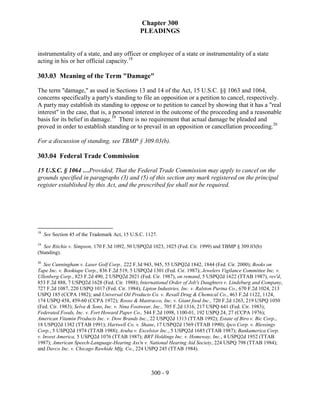



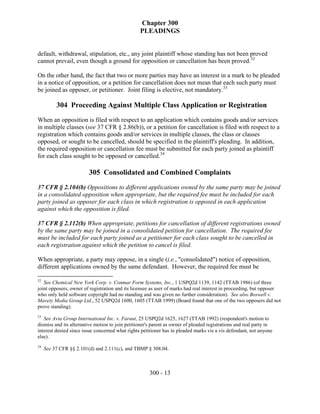

![Chapter 300
PLEADINGS
306 Time for Filing Opposition
306.01 In General
15 U.S.C. § 1062(a) [Section 12(a) of the Trademark Act] Upon the filing of an application for
registration and payment of the prescribed fee, the Director shall refer the application to the
examiner in charge of the registration of marks who shall cause an examination to be made and,
if on such examination it shall appear that the applicant is entitled to registration, or would be
entitled to registration upon the acceptance of the statement of use required by section 1(d) of
this Act, the Director shall cause the mark to be published in the Official Gazette of the Patent
and Trademark Office....
15 U.S.C. § 1063(a) [Section 13(a) of the Trademark Act] Any person who believes that he
would be damaged by the registration of a mark upon the principal register, including as a result
of dilution under section 43(c), may, upon payment of the prescribed fee, file an opposition in the
Patent and Trademark Office, stating the grounds therefor, within thirty days after the
publication under subsection (a) of section 12 of this Act of the mark sought to be registered.
Upon written request prior to the expiration of the thirty-day period, the time for filing
opposition shall be extended for an additional thirty days, and further extensions of time for
filing opposition may be granted by the Director for good cause when requested prior to the
expiration of an extension. The Director shall notify the applicant of each extension of the time
for filing opposition. ...
37 CFR § 2.101 Filing an opposition
(a) An opposition proceeding is commenced by filing a timely opposition, together with the
required fee, in the Office.
* * * *
(c) The opposition must be filed within thirty days after publication (§2.80) of the application
being opposed or within an extension of time (§2.102) for filing an opposition.
* * * *
(d)(4) The filing date of an opposition is the date of receipt in the Office of the opposition
together with the required fee.
1445 (TTAB 1987) (joint motion to consolidate granted in view of identity of parties and issues), and Federated
Department Stores, Inc. v. Gold Circle Insurance Co., 226 USPQ 262, 263 (TTAB 1985) (consolidation permitted;
issues of fact and law substantially similar).
300 - 15](https://image.slidesharecdn.com/300-130323073311-phpapp02/85/300-15-320.jpg)

![Chapter 300
PLEADINGS
the Board's action. No proceeding will be instituted, and any submitted opposition fee will be
refunded.44
306.04 Late Opposition
Because the timeliness requirements of Section 13(a) of the Act, 15 U.S.C. § 1063(a), for the
filing of an opposition are statutory, they cannot be waived by stipulation of the parties, nor can
they be waived by the Director on petition.45
Accordingly, an opposition filed after the expiration of the would-be opposer's time for opposing
must be denied by the Board as late. The opposition will not be instituted, and any submitted
opposition fee will be refunded. The would-be opposer's remedy lies in the filing of a petition
for cancellation, pursuant to Section 14 of the Act, 15 U.S.C. § 1064, when and if a registration
is issued.
307 Time for Filing Petition to Cancel
15 U.S.C. § 1064 [Section 14 of the Trademark Act] A petition to cancel a registration of a
mark, stating the grounds relied upon, may, upon payment of the prescribed fee, be filed as
follows by any person who believes that he is or will be damaged, including as a result of
dilution under section 43(a), by the registration of a mark on the principal register established
by this Act, or under the Act of March 3, 1881, or the Act of February 20, 1905:
(1) Within five years from the date of the registration of the mark under this Act.
(2) Within five years from the date of publication under section 12(c) hereof of a mark
registered under the Act of March 3, 1881, or the Act of February 20, 1905.
(3) At any time if the registered mark becomes the generic name for the goods or
services, or a portion thereof, for which it is registered, or is functional or has been
abandoned, or its registration was obtained fraudulently or contrary to the provisions of
section 4 or of subsection (a), (b), or (c) of section 2 for a registration under this Act, or
contrary to similar prohibitory provisions of such prior Acts for a registration under such
Acts, or if the registered mark is being used by, or with the permission of, the registrant
so as to misrepresent the source of the goods or services on or in connection with which
the mark is used. If the registered mark becomes the generic name for less than all of the
44
Cf. TBMP §§ 119.03 (Papers and Fees) and 202.03 (Premature Request).
45
See In re Sasson Licensing Corp., 35 USPQ2d 1510, 1512 (Comm’r 1995) (waiver of Rule 1.8 would effectively
waive Section 13 and, in any event, fact that potential opposer did not retain executed hard copies of documents
filed with Office and cannot prove document was timely is not an extraordinary circumstance justifying a waiver of
Rule 1.8); In re Kabushiki Kaisha Hitachi Seisakusho, 33 USPQ2d 1477, 1478 (Comm’r 1994); and In re Cooper,
209 USPQ 670, 671 (Comm'r 1980).
300 - 17](https://image.slidesharecdn.com/300-130323073311-phpapp02/85/300-17-320.jpg)
![Chapter 300
PLEADINGS
goods or services for which it is registered, a petition to cancel the registration for only
those goods or services may be filed. A registered mark shall not be deemed to be the
generic name of goods or services solely because such mark is also used as a name of or
to identify a unique product or service. The primary significance of the registered mark
to the relevant public rather than purchaser motivation shall be the test for determining
whether the registered mark has become the generic name of goods or services on or in
connection with which it has been used.
(4) At any time if the mark is registered under the Act of March 3, 1881, or the Act of
February 20, 1905, and has not been published under the provisions of subsection (c) of
section 12 of this Act.
(5) At any time in the case of a certification mark on the ground that the registrant (A)
does not control, or is not able legitimately to exercise control over, the use of such mark,
or (B) engages in the production or marketing of any goods or services to which the
certification mark is applied, or (C) permits the use of the certification mark for purposes
other than to certify, or (D) discriminately refuses to certify or to continue to certify the
goods or services of any person who maintains the standards or conditions which such
mark certifies:
Provided, That the Federal Trade Commission may apply to cancel on the grounds specified in
paragraphs (3) and (5) of this section any mark registered on the principal register established
by this Act, and the prescribed fee shall not be required.
15 U.S.C. § 1092 [Section 24 of the Trademark Act] Marks for the supplemental register shall
not be published for or be subject to opposition, but shall be published on registration in the
Official Gazette of the Patent and Trademark Office. Whenever any person believes that he is or
will be damaged by the registration of a mark on this register, including as a result of dilution
under section 43(c), he may at any time, upon payment of the prescribed fee and the filing of a
petition stating the ground therefor, apply to the Director to cancel such registration. The
Director shall refer such application to the Trademark Trial and Appeal Board which shall give
notice thereof to the registrant. If it is found after a hearing before the Board that the registrant
is not entitled to registration, or that the mark has been abandoned, the registration shall be
cancelled by the Director. However, no final judgment shall be entered in favor of an applicant
under section 1(b) before the mark is registered, if such applicant cannot prevail without
establishing constructive use pursuant to section 7(c).
37 CFR § 2.111 Filing petition for cancellation.
(a) A cancellation proceeding is commenced by the filing of a timely petition for cancellation,
together with the required fee, in the Office.
300 - 18](https://image.slidesharecdn.com/300-130323073311-phpapp02/85/300-18-320.jpg)

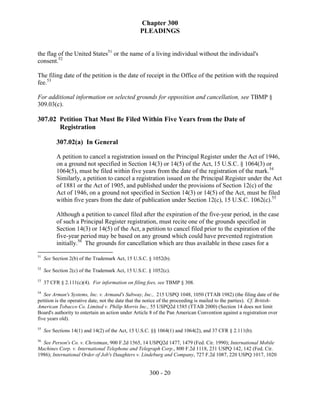
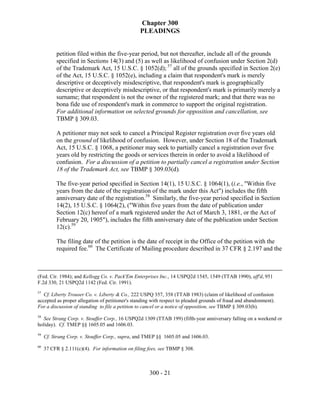

![Chapter 300
PLEADINGS
proceeding, if the five-year period had not yet expired with respect to the
registration at the time of the filing of the petition to cancel.
307.02(c)(2) Amendment of Registration
When a Principal Register registration has been amended, the registration is
subject to attack under Section 14 of the Act, 15 U.S.C. § 1064, to the extent that
the amendment of the registration has in any way enlarged registrant's rights, as
though the registration had issued on the date of the amendment. That is, even
though the Section 14 five-year period following issuance of the registration, or
publication under Section 12(c), 15 U.S.C. § 1062(c), may have expired, if a
petition to cancel the registration is filed within the five years following the
amendment of the registration, the petition is not limited to Section 14(3) or 14(5)
(15 U.S.C. § 1064(3) or 1064(5)) grounds, to the extent that the amendment has in
any way enlarged the registrant's rights. Rather, during the five years after the
amendment, "the modified registration, not having been in existence for five
years, may be challenged in a cancellation proceeding as long as petitioner states
grounds [not limited to Section 14(3) or 14(5) grounds] for the cancellation
indicating how he believes he is or will be damaged by the modified
registration."64
307.03 Premature Petition to Cancel
Sections 14 and 24 of the Act, 15 U.S.C. §§ 1064 and 1092, provide for the filing of a petition to
cancel "a registration of a mark." Until a registration actually issues, there is no registration.
Thus, if a petition to cancel a registration is filed prior to the issuance of the registration, it is
premature, and will be rejected by the Board, even if the registration has issued by the time of the
Board's action. The petition to cancel will not be instituted, and any submitted petition fee will
be refunded. Petitioner's remedy lies in the filing of a new petition to cancel after the registration
has issued.
64
Stanspec Co. v. American Chain & Cable Company, Inc., 531 F.2d 563, 189 USPQ 420, 423 (CCPA 1976). See
Continental Gummi-Werke AG v. Continental Seal Corp., 222 USPQ 822, 824-25 (TTAB 1984) (counterclaim
would be proper where defendant pleads that the amendment to the mark in the subject registration resulted in a
mark materially different from originally registered mark, representing enlargement of rights conferred by original
certificate of registration; that defendant used its mark prior to opposer's first use of amended mark; and that
confusion with amended mark is likely).
300 - 23](https://image.slidesharecdn.com/300-130323073311-phpapp02/85/300-23-320.jpg)
![Chapter 300
PLEADINGS
307.04 Late Petition to Cancel
A petition to cancel a registration issued on the Principal Register under the Act of 1946 on a
ground not specified in Section 14(3) or 14(5) of the Act, 15 U.S.C. § 1064(3) or 1064(5), must
be filed (with the required fee) within five years from the date of the registration of the mark.
Similarly, a petition to cancel a registration issued on the Principal Register under the Act of
1881 or the Act of 1905, and published under the provisions of Section 12(c) of the Act of 1946,
15 U.S.C. § 1062(c), on a ground not specified in Section 14(3) or 14(5) of the Act, must be filed
within five years from the date of publication under Section 12(c).65
If a petition to cancel one of these Principal Register registrations is filed after the expiration of
the five-year period and does not plead one or more of the grounds specified in Section 14(3) or
14(5) of the Act, the petition is late, and will be rejected by the Board. The petition to cancel
will not be instituted, and any submitted petition fee will be refunded. However, the rejection of
the petition is without prejudice to petitioner's right to file, at any time thereafter, a new petition
to cancel the registration, and to plead therein one or more of the grounds specified in Section
14(3) or 14(5).
For information concerning the effect of signature and fee requirements on the timing of a
petition to cancel, see TBMP §§ 308.02(b) (Insufficient Fee) and 309.02(b) (Signature of
Complaint).
308 Filing Fees
308.01 Fee for Filing Opposition
308.01(a) In General
15 U.S.C. § 1063(a) [Section 13(a) of the Trademark Act] Any person who believes that
he would be damaged by the registration of a mark upon the principal register, including
as a result of dilution under section 43(c), may, upon payment of the prescribed fee, file
an opposition in the Patent and Trademark Office....
37 CFR § 2.101 Filing an opposition.
(a) An opposition proceeding is commenced by filing a timely opposition, together with
the required fee, in the Office.
* * * *
65
See Section 14 of the Act, 15 U.S.C. § 1064, and 37 CFR § 2.111(b).
300 - 24](https://image.slidesharecdn.com/300-130323073311-phpapp02/85/300-24-320.jpg)
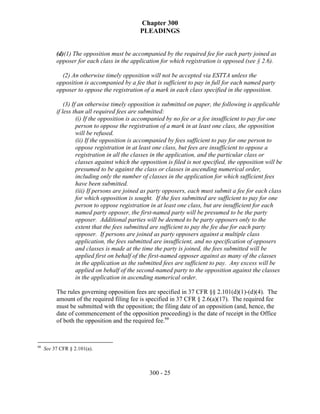

![Chapter 300
PLEADINGS
308.02 Fee for Filing Petition to Cancel
308.02(a) In General
15 U.S.C. § 1064 [Section 14 of the Trademark Act] A petition to cancel a registration
of a mark, stating the grounds relied upon, may, upon payment of the prescribed fee, be
filed as follows by any person who believes that he is or will be damaged, including as a
result of dilution under section 43(c), by the registration of a mark on the principal
register established by this Act, or under the Act of March 3, 1881, or the Act of
February 20, 1905....
15 U.S.C. § 1092 [Section 24 of the Trademark Act] Marks for the supplemental register
shall not be published for or be subject to opposition, but shall be published on
registration in the Official Gazette of the Patent and Trademark Office. Whenever any
person believes that he is or will be damaged by the registration of a mark on this
register, including as a result of dilution under section 43(c), he may at any time, upon
payment of the prescribed fee and the filing of a petition stating the ground therefor,
apply to the Director to cancel such registration. ...
37 CFR § 2.111(c)
(1) The petition for cancellation must be accompanied by the required fee for each party
joined as petitioner for each class in the registration for which cancellation is sought (see
§2.6).
(2) An otherwise timely petition for cancellation will not be accepted via ESTTA unless
the petition for cancellation is accompanied by a fee that is sufficient to pay in full for
each named party petitioner to petition for cancellation of the registration of a mark in
each class specified in the petition for cancellation.
(3) If an otherwise timely petition for cancellation is submitted on paper, the following is
applicable if less than all required fees are submitted:
(i) If the petition for cancellation is accompanied by no fee or a fee insufficient to
pay for one person to petition for cancellation against at least one class in the
registration, the petition for cancellation will be refused.
(ii) If the petition for cancellation is accompanied by fees sufficient to pay for one
person to petition for cancellation against at least one class in the registration,
but fees are insufficient for a petition for cancellation against all the classes in the
registration, and the particular class or classes against which the petition for
cancellation is filed is not specified, the petition for cancellation will be presumed
to be against the class or classes in ascending numerical order, including only the
number of classes in the registration for which sufficient fees have been
submitted.
300 - 27](https://image.slidesharecdn.com/300-130323073311-phpapp02/85/300-27-320.jpg)





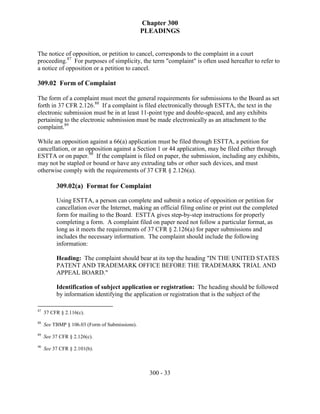

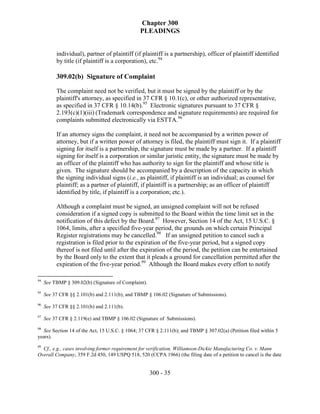
![Chapter 300
PLEADINGS
petitioners of unsigned complaints before the expiration of any applicable statutory
deadline, so that the informality may be corrected prior to the deadline, the Board has no
obligation to do so, and cannot assume the burden of discovering filing errors within any
specified time.100
309.02(c) Service of Complaint
The complaint need not be served by the plaintiff on the defendant. Rather, the
complaint, and any exhibits thereto, will be forwarded to the defendant by the Board
itself.101
309.03 Substance of Complaint
15 U.S.C. § 1068 [Section 18 of the Trademark Act] In such proceedings the Director may
refuse to register the opposed mark, may cancel the registration, in whole or in part, ....
37 CFR § 2.99(h) The Trademark Trial and Appeal Board will consider and determine
concurrent use rights only in the context of a concurrent use registration proceeding.
37 CFR § 2.104(a) The opposition must set forth a short and plain statement showing why the
opposer believes he, she or it would be damaged by the registration of the opposed mark and
state the grounds for opposition.
37 CFR § 2.111(b) Any person who believes that he, she or it is or will be damaged by a
registration may file a petition, addressed to the Trademark Trial and Appeal Board, for
cancellation of the registration in whole or in part. ...
of receipt in the USPTO of the verified petition and filing fee); Texas Instruments Inc. v. Conklin Instrument Corp.,
161 USPQ 740, 741 (TTAB 1969) (unverified petition timely filed but ineffective; verified substitute petition
untimely); TBMP § 308.02(b) (Insufficient Fee); and Saul Lefkowitz and Janet E. Rice, Adversary Proceedings
Before the Trademark Trial and Appeal Board, 75 Trademark Rep. 323, 329 (1985). Cf. also In re L.R. Sport Inc.,
25 USPQ2d 1533, 1534 (Comm'r 1992) (timely payment of filing fee for statement of use is statutory and cannot be
waived).
100
Cf. In re Holland American Wafer Co., 737 F.2d 1015, 222 USPQ 273, 275 (Fed. Cir. 1984) (regarding rejection
of renewal application); In re L.R. Sport Inc., 25 USPQ2d 1533, 1534 (Comm'r 1992) (regarding rejection of
statement of use); and In re Application Papers Filed November 12, 1965, 152 USPQ 194, 195 (Comm'r 1966)
(regarding insufficient filing fee for patent application).
101
See 37 CFR §§ 2.105(b) and (c), 2.113(b) and (c), and 2.119(a). See also TBMP § 310 (Notification to Parties of
Proceeding).
300 - 36](https://image.slidesharecdn.com/300-130323073311-phpapp02/85/300-36-320.jpg)

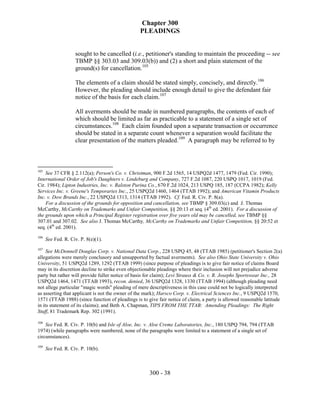

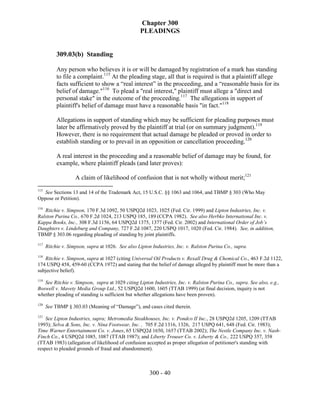
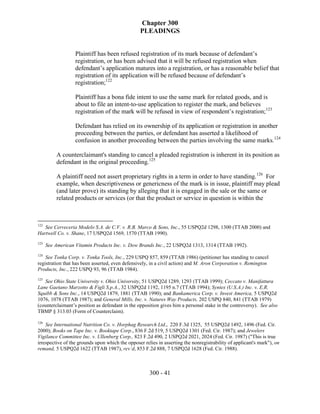

![Chapter 300
PLEADINGS
A plaintiff cannot rely upon an unpleaded claim unless the plaintiff's pleading is amended
(or deemed amended), pursuant to Fed. R. Civ. P. 15(a) or (b), to assert the matter.131
Examples of available grounds for opposition and for cancellation are listed below.
[NOTE: The grounds identified in examples 3 and 4, and 12 through 14 are available for
cancellation of a Principal Register registration over five years old.] This list is
exemplary, not exhaustive.
(1) Section 2(d) of the Act, 15 U.S.C. § 1052(d): That defendant's mark so resembles a
mark registered in the Office, or a mark or trade name previously used in the United
States by another and not abandoned, as to be likely, when used on or in connection with
the goods or services of the defendant, to cause confusion, or to cause mistake, or to
deceive.132
(2) The grounds specified in Section 2(e) of the Act, 15 U.S.C. § 1052(e); for example,
that defendant's mark, when used on or in connection with the goods or services of the
defendant, is merely descriptive or deceptively misdescriptive of them,133 or that
defendant's mark is primarily geographically descriptive134 or primarily geographically
deceptively misdescriptive of them;135 and that defendant's mark is primarily merely a
surname.136
131
See TBMP § 314 (Unpleaded Matters).
132
See, e.g., Opryland USA Inc. v. The Great American Music Show Inc., 970 F.2d 847, 23 USPQ2d 1471, 1473
(Fed. Cir. 1992) and Time Warner Entertainment Co. v. Jones, 65 USPQ2d 1650 (TTAB 2002).
133
See Section 2(e)(1) of the Trademark Act, 15 U.S.C. § 1052(e)(1). See also, e.g., The Hoover Co. v. Royal
Appliance Mfg. Co., 238 F.3d 1357, 57 USPQ2d 1720 (Fed. Cir. 2001) (deceptive misdescriptiveness) and
Callaway Vineyard & Winery v. Endsley Capital Group, Inc., 63 USPQ2d 1919 (TTAB 2002) (mere
descriptiveness).
134
See Section 2(e)(2) of the Trademark Act, 15 U.S.C. § 1052(e)(2). See also, e.g., University Book Store v.
University of Wisconsin Board of Regents, 33 USPQ 1385 (TTAB 1994).
135
See Section 2(e)(3) of the Trademark Act, 15 U.S.C. § 1052(e)(3). See also In re California Innovations, Inc.,
329 F.3d 1334, 66 USPQ2d 1853 (Fed. Cir. 2003); In re Save Venice New York, Inc., 259 F.3d 1346, 59 USPQ2d
1778 (Fed. Cir. 2001); and In re Wada, 48 USPQ2d 1689 (TTAB 1998), aff'd, 194 F.3d 1297, 52 USPQ2d 1539
(Fed. Cir. 1999).
136
See Section 2(e)(4) of the Trademark Act, 15 U.S.C. § 1052(e)(4). See also e.g., Michael S. Sachs Inc. v.
Cordon Art B.V., 56 USPQ2d 1132 (TTAB 2000); Kellogg Co. v. Pack'Em Enterprises Inc., 14 USPQ2d 1545
(TTAB 1990), aff’d, 951 F.2d 330, 21 USPQ2d 1142 (Fed. Cir. 1991); Allied Mills, Inc. v. Kal Kan Foods, Inc., 203
USPQ 390, 391-92 (TTAB 1979); and Food Specialty Co. v. Carnation Co., 170 USPQ 522, 523 (TTAB 1971).
300 - 43](https://image.slidesharecdn.com/300-130323073311-phpapp02/85/300-43-320.jpg)

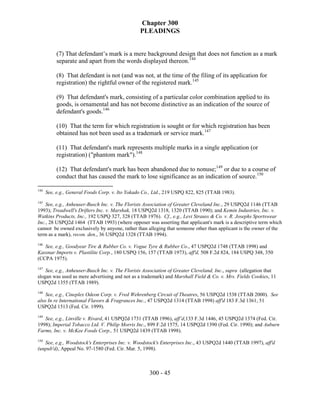
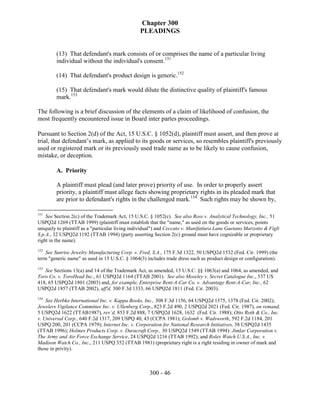
![Chapter 300
PLEADINGS
for example, ownership of an application with a filing date (or a registration with an
underlying application filing date) prior to any date of first use on which defendant can
rely;155 prior trademark or service mark use;156 or prior use analogous to trademark or
service mark use.157
However, priority is not in issue in an opposition where opposer pleads (and later proves)
that it owns a registration for its pleaded mark,158 provided that any counterclaim or
separate petition to cancel the pleaded registration by the applicant is ultimately
dismissed and the registration remains uncancelled.159
155
See Larami Corp. v. Talk To Me Programs Inc., 36 USPQ2d 1840 (TTAB 1995) (owner of an intent-to-use
application may rely on its application filing date as a constructive use date for purposes of priority); and Zirco
Corp. v. American Telephone and Telegraph Co., 21 USPQ2d 1542, 1544 (TTAB 1991). See also Brewski Beer Co.
v. Brewski Brothers Inc., 47 USPQ2d 1281, 1284 (TTAB 1998) (if the underlying application filing date of
petitioner’s pleaded registration was earlier than the filing date of respondent's underlying application, petitioner
could take its chances and elect to make of record simply a copy of its registration as proof of first use as of the
filing date of the underlying application); American Standard Inc. v. AQM Corporation, 208 USPQ 840, 842 (TTAB
1980); and Gor-Ray Limited v. Garay & Co., Inc., 167 USPQ 694 (TTAB 1970) (a cancellation petitioner is entitled
to rely on the filing date of its pleaded registration as prima facie evidence of its first use of the mark).
156
See Corporate Document Services Inc. v. I.C.E.D. Management Inc., 48 USPQ2d 1477, 1479 (TTAB 1998)
(interstate or intrastate commerce is sufficient) and Jimlar Corporation v. The Army and Air Force Exchange
Service, 24 USPQ 1216, 1221 (TTAB 1992).
157
See T.A.B. Systems v. PacTel Teletrac, 77 F.3d 1372, 37 USPQ2d 1879, 1881 (Fed. Cir. 1996) (must show that
the activities claimed to constitute analogous use have had "substantial impact" on the purchasing public);
Martahus v. Video Duplication Services Inc., 3 F.3d 417, 27 USPQ2d 1846, 1850 (Fed. Cir. 1993) (trade name use);
National Cable Television Association Inc. v. American Cinema Editors Inc., 937 F.2d 1572, 19 USPQ2d 1424,
1428 (Fed. Cir. 1991) (trade name use); Shalom Children’s Wear Inc. v. In-Wear A/S, 26 USPQ2d 1516, 1519
(TTAB 1993) (priority of use against ITU application may be established with prior use analogous to trademark use)
and Corporate Document Services Inc. v. I.C.E.D. Management Inc., supra (owner of ITU application may rely on
prior use analogous to trademark use).
158
See King Candy Co., Inc. v. Eunice King’s Kitchen, Inc., 496 F.2d 1400, 182 USPQ 108, 110 (CCPA 1974);
("Board must consider existing registrations of subsequent-user opposers because ... [Section 2(d) provides that] an
applicant can register, unless his mark is likely to cause confusion with a mark 'registered in the Patent Office or * *
* previously used * * *'..."); SCOA Industries, Inc. v. Kennedy & Cohen, Inc., 188 USPQ 411, 413 (TTAB 1975),
appeal dismissed, 189 USPQ 15 (CCPA 1976); and Penguin Books Ltd. V. Eberhard, 48 USPQ2d 1280 (TTAB
1998). Cf., regarding cancellation proceedings, Brewski Beer Co. v. Brewski Brothers Inc., supra (in a cancellation
proceeding the registrations of each party offset each other and petitioner must, in the first instance, establish prior
rights); and American Standard Inc. v. AQM Corp., supra at 841 (priority must be proven in cancellation
proceeding).
159
See, e.g., Contour Chair-Lounge Co., Inc. v. The Englander Company, Inc., 324 F.2d 186, 139 USPQ 285, 286
(CCPA 1963) (as long as a registration relied on by an opposer remains uncancelled, it will be treated as valid and
entitled to all statutory presumptions; having dismissed petition to cancel pleaded registrations, and since no appeal
was taken, Board was obligated to treat opposer's registrations as valid and as though no such petition had been
filed). Cf. Penguin Books Ltd. v. Eberhard, supra (petition or counterclaim to restrict the scope of goods in
registration under Section 18 of the Trademark Act was not a collateral attack on the validity of that registration).
300 - 47](https://image.slidesharecdn.com/300-130323073311-phpapp02/85/300-47-320.jpg)

![Chapter 300
PLEADINGS
standing and as part of the pleading of a ground under Section 2(d) of the Act, 15 U.S.C.
§1052(d)); etc. Thus, a plaintiff wishing to plead likelihood of confusion hypothetically
in a proceeding based upon Section 2(d) might assert, for example, that if, as the
trademark examining attorney (or the defendant) contends, plaintiff's mark so resembles
defendant's mark as to be likely, when applied to the goods and/or services of the
plaintiff, to cause confusion, then the registration sought by defendant should be refused
(or defendant's registration should be cancelled) because plaintiff has priority of use.165
309.03(d) Remedy Under Section 18 (Partial Opposition or Partial
Cancellation)
15 U.S.C. § 1068 [Section 18 of the Trademark Act] In such proceedings the Director
may refuse to register the opposed mark, may cancel the registration, in whole or in part,
may modify the application or registration by limiting the goods or services specified
therein, may otherwise restrict or rectify with respect to the register the registration of a
registered mark, may refuse to register any or all of several interfering marks, or may
register the mark or marks for the person or persons entitled thereto, as the rights of the
parties hereunder may be established in the proceedings....
37 CFR § 2.111(b) Any person who believes that he, she or it is or will be damaged by a
registration may file a petition, addressed to the Trademark Trial and Appeal Board, for
cancellation of the registration in whole or in part. ...
37 CFR § 2.133(b) If, in an inter partes proceeding, the Trademark Trial and Appeal
Board finds that a party whose application or registration is the subject of the proceeding
is not entitled to registration in the absence of a specified restriction to the involved
application or registration, the Trademark Trial and Appeal Board will allow the party
time in which to file a request that the application or registration be amended to conform
to the findings of the Trademark Trial and Appeal Board, failing which judgment will be
entered against the party.
165
See Humana Inc. v. Humanomics Inc., 3 USPQ2d 1696, 1698 (TTAB 1987) (applicant could have raised priority
issue in a counterclaim by pleading likelihood of confusion hypothetically notwithstanding the inconsistency of that
pleading with its position in the opposition that the marks are not confusingly similar); Home Juice Co. v. Runglin
Cos., 231 USPQ 897, 899 (TTAB 1986) (pleading construed as hypothetical pleading of likelihood of confusion
which is appropriate where petitioner's standing is based on its inability to secure a registration, notwithstanding that
it is the senior user, because the subject registration has been cited as a reference by the examining attorney). See
also, Taffy's of Cleveland, Inc. v. Taffy's, Inc., 189 USPQ 154, 156-57 (TTAB 1975) (fact that petitioner argued
before examining attorney that its mark and that of respondent were not confusingly similar does not preclude
petitioner from asserting likelihood of confusion as ground for cancellation); and Revco, D.S., Inc. v. Armour-Dial,
Inc., supra (in seeking to cancel on ground of abandonment, plaintiff asserted proper hypothetical pleading of
likelihood of confusion as its basis for standing).
300 - 49](https://image.slidesharecdn.com/300-130323073311-phpapp02/85/300-49-320.jpg)

![Chapter 300
PLEADINGS
with greater particularity in terms of type, use, channels of trade, etc., is in the nature of
an equitable remedy under Section 18 and does not require pleading and proof of specific
grounds for cancellation or opposition, such as abandonment.170 However, the Board will
not permit an action to restrict or modify the goods or services in this manner where such
a claim is divorced from the question of likelihood of confusion.171 Thus, a party seeking
to restrict an opponent's broadly worded identification of goods or services, in a case
involving likelihood of confusion, must plead and prove that (i) the entry of a proposed
restriction to the goods or services in its opponent's application or registration will avoid
a finding of likelihood of confusion and (ii) the opponent is not using its mark on those
goods or services that will be effectively excluded from the application or registration if
the proposed restriction is entered.172
In considering a restriction of a registration, the Board will look to the nature of the use
made by registrant as of the time the restriction is sought, not as of the time registration
was sought.173
A petition to partially cancel a registration by restricting the goods or services in a
particular manner in terms of type, use, channels of trade, etc., in order to avoid a
likelihood of confusion can be made against registrations over 5 years old as well as
those less than 5 years old.174 Such claim is in the nature of an equitable remedy and does
not constitute an attack on the validity of a registration.175
A petition to restrict or clarify the description of a mark in a registration would fall under
the provision giving Board authority to "restrict or rectify" the register.176 As in the case
170
See Eurostar, supra at 1271 & 1271 n.3. See also DAK, supra at 1437.
171
See DAK, supra at 1437 and Eurostar, supra at 1270. [Note: To the extent that cases decided prior to Eurostar
permitted a restriction petition in the absence of a pleading that the restriction sought will avoid a likelihood of
confusion, and to the extent that those cases required the pleading and proof of a separate ground of nonuse or
abandonment, those cases were expressly overruled by Eurostar.]
172
See Eurostar, supra at 1270. See also, for example, Penguin Books Ltd. v. Eberhard, 48 USPQ2d 1280, 1286
(TTAB 1998) (applicant's attempt to restrict opposer's registration for computer programs to "computer programs
except computer programs for maintenance management" was rejected as it did not serve to avoid likelihood of
confusion since proposed restriction failed to delineate different users or different channels of trade).
173
See Milliken & Co. v. Image Industries Inc., supra.
174
See Eurostar, supra at 1271 n.3.
175
See, for example, Penguin Books Ltd. v. Eberhard, supra at 1286 (counterclaim to partially cancel pleaded
registration to restrict scope of goods therein did not preclude opposer's reliance on pleaded registration to establish
priority in the opposition).
176
See Wellcome Foundation Ltd, supra at 1479.
300 - 51](https://image.slidesharecdn.com/300-130323073311-phpapp02/85/300-51-320.jpg)
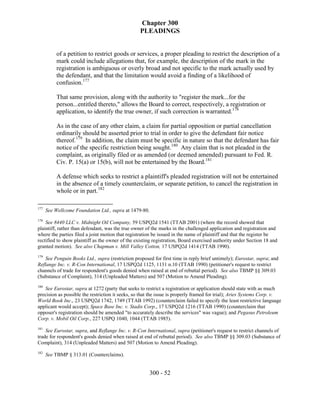
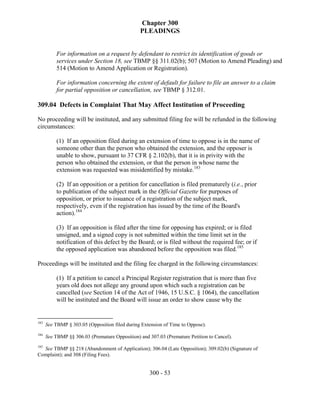
![Chapter 300
PLEADINGS
petition should not be dismissed for failure to state a claim. Any fee submitted
therewith will not be refunded.
(2) If a petition for cancellation is filed with respect to a registration which, at
the time of the filing of the petition, was not a "live" registration (e.g., the time
for filing an affidavit of use under Section 8 of the Act of 1946, 15 U.S.C. §
1058, had expired, and no acceptable affidavit had been filed; the registration
had already been cancelled as the result of a previous cancellation proceeding),
the proceeding will be instituted, and then dismissed as moot. Any fee
submitted with the petition for cancellation will not be refunded.
(3) If a party files an opposition or a petition for cancellation, and immediately
thereafter changes its mind, and requests that the opposition or petition for
cancellation not be instituted and that the papers be returned, the request
ordinarily will be denied, and the proceeding will be instituted, unless there is a
defect in the opposition or petition for cancellation which precludes institution,
in which case no proceeding will be instituted, and any submitted fee will be
refunded.
When a proceeding is erroneously instituted, the proceeding will be dismissed as a nullity, rather
than vacated, so as to maintain the integrity of the proceeding numbers. The Board will retain all
papers.
310 Notification to Parties of Proceeding and Setting Time to Answer
310.01 Notification to Parties of Proceeding
37 CFR § 2.105 Notification to parties of opposition proceeding[s].
(a) When an opposition in proper form has been filed and the correct fee has been submitted, the
Trademark Trial and Appeal Board shall prepare a notification, which shall identify the title and
number of the proceeding and the application involved and shall designate a time, not less than
thirty days from the mailing date of the notification, within which an answer must be filed.
(b) The Board shall forward a copy of the notification to opposer, as follows:
(1) If the opposition is transmitted by an attorney, or a written power of attorney is filed,
the Board will send the notification to the attorney transmitting the opposition or to the
attorney designated in the power of attorney, provided that the person is an “attorney”
as defined in §10.1(c) of this chapter.
(2) If opposer is not represented by an attorney in the opposition, but opposer has
appointed a domestic representative, the Board will send the notification to the domestic
representative, unless opposer designates in writing another correspondence address.
300 - 54](https://image.slidesharecdn.com/300-130323073311-phpapp02/85/300-54-320.jpg)


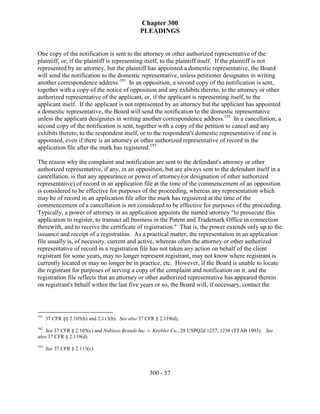

![Chapter 300
PLEADINGS
When notice of the filing of a petition to cancel is published in the Official Gazette, the published
notice allows the respondent thirty days from the publication date thereof in which to appear in
the cancellation proceeding. If respondent fails to appear within the time allowed, default
judgment may be entered against respondent.
For information concerning the procedure followed by the Board in a concurrent use proceeding
when a communication sent by the Board to a specified excepted user is returned as
undeliverable, see TBMP § 1106.05.
310.03 Setting Time for Filing Answer
310.03(a) In General
37 CFR § 2.105 Notification to parties of opposition proceeding[s].
(a) When an opposition in proper form has been filed and the correct fee has been
submitted, the Trademark Trial and Appeal Board shall prepare a notification, which
shall identify the title and number of the proceeding and the application involved and
shall designate a time, not less than thirty days from the mailing date of the notification,
within which an answer must be filed.
37 CFR § 2.113 Notification to parties of cancellation proceeding.
(a) When a petition for cancellation has been filed in proper form (see §§ 2.111 and
2.112), the Trademark Trial and Appeal Board shall prepare a notification which shall
identify the title and number of the proceeding and the registration(s) involved and shall
designate a time, not less than thirty days from the mailing date of the notification, within
which an answer must be filed.
Trademark Rules 2.105(a) and 2.113(a), 37 CFR §§ 2.105(a) and 2.113(a), provide, in
part, that the Board's notification of the filing of an opposition or petition to cancel "shall
designate a time, not less than thirty days from the mailing date of the notification, within
which an answer must be filed." A defendant is under no obligation to file an answer to
the complaint in an opposition or cancellation proceeding until it receives the Board's
notification setting the time for filing an answer.198 It is the general practice of the Board
to allow the defendant in an opposition or cancellation proceeding 40 days from the
mailing date of the notification in which to file its answer.
For information on the time for filing an answer to a counterclaim, see TBMP § 313.06.
198
See Nabisco Brands Inc. v. Keebler Co., 28 USPQ2d 1237, 1238 (TTAB 1993).
300 - 59](https://image.slidesharecdn.com/300-130323073311-phpapp02/85/300-59-320.jpg)
![Chapter 300
PLEADINGS
310.03(b) Trademark Rule 2.119(c) 5-Day Addition Not Applicable to
Deadlines Set by Board
Trademark Rule 2.119(c), 37 CFR § 2.119(c), provides, in part, that "[w]henever a party
is required to take some action within a prescribed period after the service of a paper on
the party by another party and the paper is served by first-class mail, 'Express Mail' or
overnight courier, 5 days shall be added to the prescribed period." This provision, by its
very terms, applies only when a party has to take some action within a prescribed period
after the service of a paper on it by another party (and service of the paper was made in
one of three specified ways). It does not apply to an action that must be taken by a party
within a time set in a communication from the Board.
Thus, when a Board notification allows the defendant 40 days from the mailing date of
the notification in which to file an answer to the complaint, the answer is due on or before
the 40th day, not on the 45th day. Similarly, when the Board allows a counterclaim
defendant 30 days from the mailing date of the Board's notification in which to file an
answer to the counterclaim, the answer is due on or before the 30th day, not on the 35th
day.
310.03(c) Extension of Time to File Answer
The time for filing an answer may be extended or reopened by stipulation of the parties,
approved by the Board, or on motion granted by the Board, or by order of the Board.199
However, due dates for answers to complaints may not be extended beyond the close of
discovery. A motion to extend the time to answer beyond the close of discovery, even if
consented, will be denied. Thus, any extension request, which would reset the time to
answer beyond the date presently set for the close of discovery, must also include a
request for an extension of the discovery period.
311 Form and Content of Answer
311.01 Form of Answer
37 CFR § 2.126 Form of submissions to the Trademark Trial and Appeal Board.
(a) Submissions may be made to the Trademark Trial and Appeal Board on paper where Board
practice or the rules in this part permit. A paper submission, including exhibits and depositions,
must meet the following requirements:
(1) A paper submission must be printed in at least 11-point type and double-spaced, with text
on one side only of each sheet;
199
See Fed. R. Civ. P. 6(b), and TBMP § 509 (Motion to Extend Time).
300 - 60](https://image.slidesharecdn.com/300-130323073311-phpapp02/85/300-60-320.jpg)


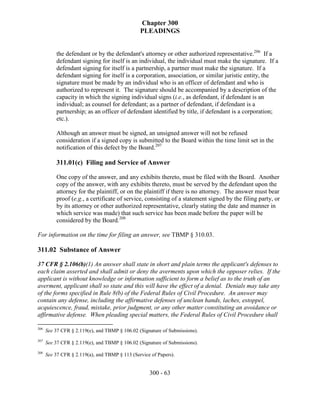
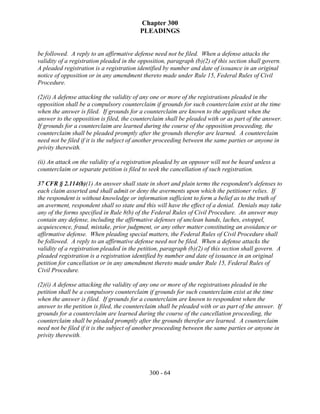




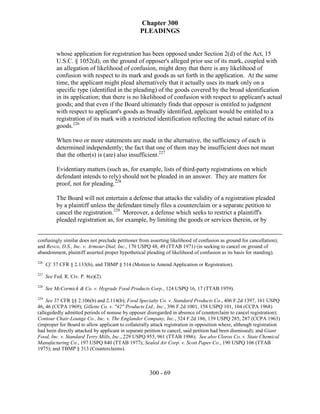
![Chapter 300
PLEADINGS
deleting some of the goods or services, will not be entertained in the absence of a timely
counterclaim, or separate petition, to cancel the registration in whole or in part.230
Geographic restrictions will be considered and determined by the Board only within the
context of a concurrent use registration proceeding.231
Although Trademark Rules 2.106(b)(2)(ii) and 2.114(b)(2)(ii), 37 CFR §§2.106(b)(2)(ii)
and 2.114(b)(2)(ii), specifically permit a defense attacking the validity of a plaintiff's
pleaded registration to be raised either as a counterclaim or as a separate petition to
cancel, the better practice is to raise the defense as a counterclaim.232 If the defense is
raised as a separate petition to cancel, however, the petition itself and any covering letter
filed therewith should include a reference to the original proceeding.233
When a defense is raised by way of a counterclaim, it should not also be pleaded as an
affirmative defense, because the pleading of it as an affirmative defense is unnecessary
and redundant.234
311.02(c) Unpleaded Affirmative Defenses
Except as provided in Fed. R. Civ. P. 12(b) and 12(h)(2) (which allow a defendant to
raise certain specified defenses by motion), an unpleaded defense cannot be relied upon
by the defendant unless the defendant's pleading is amended (or deemed amended),
pursuant to Fed. R. Civ. P. 15(a) or 15(b), to assert the matter.235
230
See 37 CFR § 2.133(d) and Penguin Books Ltd. V. Eberhard, 48 USPQ2d 1280, 1287 (TTAB 1998) (applicant’s
request raised in reply brief for a restriction of opposer’s registration [beyond applicant's initial counterclaim to
restrict] was untimely as it should have been raised by promptly moving to amend). See also TBMP §§ 309.03(d)
(regarding claims for partial cancellation under Section 18) and 313 (regarding counterclaims).
231
See 37 CFR §§ 2.99(h) and 2.133(c). See also Snuffer & Watkins Management Inc. v. Snuffy's Inc., 17 USPQ2d
1815 (TTAB 1990).
232
See Vitaline Corp. v. General Mills Inc., 891 F.2d 273, 13 USPQ2d 1172, 1174 (Fed. Cir. 1989).
233
See Vitaline Corp. v. General Mills Inc., supra at 1174. See also TBMP § 313 (Counterclaims).
234
See Space Base Inc. v. Stadis Corp., 17 USPQ2d 1216, 1220 (TTAB 1990); Continental Gummi-Werke AG v.
Continental Seal Corp., 222 USPQ 822, 825 (TTAB 1984) (motion to strike affirmative defense predicated on same
facts alleged in counterclaim granted as representing, in effect, a collateral attack on registration); and W. R. Grace
& Co. v. Arizona Feeds, 195 USPQ 670, 671 (Comm'r 1977) (motion to strike affirmative defense which allegations
formed basis for counterclaim granted since, although Board did not find that applicant was attempting to
collaterally attack registration, the affirmative defense was repetitious and unnecessary).
235
See Fed. R. Civ. P. 8(b), 8(c), and 12(b); and Section 19 of the Trademark Act, 15 U.S.C. § 1069. See also
Chicago Corp. v. North American Chicago Corp., 20 USPQ2d 1715, 1717 n.5 (TTAB 1991) (defense that opposer
lacks proprietary rights in its common law mark raised for first time in final brief was neither pleaded nor tried);
United States Olympic Committee v. Bata Shoe Co., 225 USPQ 340, 341 (TTAB 1984) (laches is an affirmative
300 - 70](https://image.slidesharecdn.com/300-130323073311-phpapp02/85/300-70-320.jpg)
![Chapter 300
PLEADINGS
For additional information concerning unpleaded matters, see TBMP § 314.
311.02(d) Other Affirmative Pleadings - Amplifying Denials
An answer may include affirmative assertions that, although they may not rise to the level
of an affirmative defense, nevertheless state the reasons for, and thus amplify, the
defendant's denial of one or more of the allegations in the complaint. These
amplifications of denials, whether referred to as "affirmative defenses," "avoidances,"
"affirmative pleadings," or "arguments," are permitted by the Board because they serve to
give the plaintiff fuller notice of the position which the defendant plans to take in defense
of its right to registration.236
311.03 Reply to Answer Should Not be Filed
Although Trademark Rules 2.106(b) and 2.114(b) require that an answer to a counterclaim be
filed, within the time designated by the Board, they specifically provide that a reply to an
affirmative defense need not be filed.237 Similarly, Fed. R. Civ. P. 7(a) provides that there shall
be a complaint and an answer and a reply to a counterclaim denominated as such; that certain
other specified pleadings, not relevant to Board proceedings (and not including a reply to an
answer), shall be allowed; but that "[n]o other pleading shall be allowed, except that the court
may order a reply to an answer."
Thus, while a plaintiff must file an answer to a counterclaim, a reply to an answer need not, and
should not, be filed.
defense which must be specifically pleaded); Trans Union Corp. v. Trans Leasing International, Inc., 200 USPQ
748, 754 (TTAB 1978) (defense of laches, which was raised by applicant in its final brief, was not pleaded in answer
but was tried by implied consent of opposer); United States Mineral Products Co. v. GAF Corp., 197 USPQ 301,
304 n.5 (TTAB 1977) (the equitable defenses set forth in Section 19 of the Trademark Act are affirmative defenses
which must be affirmatively pleaded and in this case were neither pleaded nor tried); Copperweld Corp. v. Astralloy-
Vulcan Corp., 196 USPQ 585, 590 (TTAB 1977) (laches, while not affirmatively pleaded, was nevertheless tried
and briefed by both parties without objection); Hershey Foods Corp. v. Cerreta, 195 USPQ 246, 251 (TTAB 1977)
(laches and acquiescence were neither pleaded nor tried); and Taffy's of Cleveland, Inc. v. Taffy's, Inc., 189 USPQ
154 (TTAB 1975) (laches is affirmative defense that must be pleaded in order to be considered).
236
See Humana Inc. v. Humanomics Inc., 3 USPQ2d 1696, 1697 n.5 (TTAB 1987) (allegations under heading
"affirmative defenses" were in the nature of arguments in support of denial of claim rather than true affirmative
defenses and were treated as such); Maytag Co. v. Luskin's, Inc., 228 USPQ 747, 747 n.3 (TTAB 1986) (same);
Textron, Inc. v. Gillette Co., 180 USPQ 152, 153 (TTAB 1973) (objection to certain paragraphs of answer as
verbose and argumentative not well taken); and McCormick & Co. v. Hygrade Food Products Corp., 124 USPQ 16,
17 (TTAB 1959) (allegation that registered mark is weak does not constitute a collateral attack on validity of
opposer's registrations). Cf. Harsco Corp. v. Electrical Sciences Inc., 9 USPQ2d 1570, 1572 (TTAB 1988).
237
See 37 CFR §§ 2.106(b)(1) and (2)(iii), and 2.114(b)(1) and (2)(iii).
300 - 71](https://image.slidesharecdn.com/300-130323073311-phpapp02/85/300-71-320.jpg)
